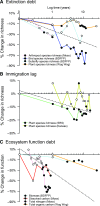Habitat fragmentation and its lasting impact on Earth's ecosystems
- PMID: 26601154
- PMCID: PMC4643828
- DOI: 10.1126/sciadv.1500052
Habitat fragmentation and its lasting impact on Earth's ecosystems
Abstract
We conducted an analysis of global forest cover to reveal that 70% of remaining forest is within 1 km of the forest's edge, subject to the degrading effects of fragmentation. A synthesis of fragmentation experiments spanning multiple biomes and scales, five continents, and 35 years demonstrates that habitat fragmentation reduces biodiversity by 13 to 75% and impairs key ecosystem functions by decreasing biomass and altering nutrient cycles. Effects are greatest in the smallest and most isolated fragments, and they magnify with the passage of time. These findings indicate an urgent need for conservation and restoration measures to improve landscape connectivity, which will reduce extinction rates and help maintain ecosystem services.
Figures




References
-
- Pereira H. M., Leadley P. W., Proenca V., Alkemade R., Scharlemann J. P. W., Fernandez-Manjarres J. F., Araujo M. B., Balvanera P., Biggs R., Cheung W. W. L., Chini L., Cooper H. D., Gilman E. L., Guenette S., Hurtt G. C., Huntington H. P., Mace G. M., Oberdorff T., Revenga C., Rodrigues P., Scholes R. J., Sumaila U. R., Walpole M., Scenarios for global biodiversity in the 21st century. Science 330, 1496–1501 (2010). - PubMed
-
- Rands M. R. W., Adams W. M., Bennun L., Butchart S. H. M., Clements A., Coomes D., Entwistle A., Hodge I., Kapos V., Scharlemann J. P. W., Sutherland W. J., Vira B., Biodiversity conservation: Challenges beyond 2010. Science 329, 1298–1303 (2010). - PubMed
-
- D. B. Lindenmayer, J. Fischer, Habitat Fragmentation and Landscape Change: An Ecological and Conservation Synthesis (Island Press, Washington, DC, 2006).
-
- Didham R. K., Kapos V., Ewers R. M., Rethinking the conceptual foundations of habitat fragmentation research. Oikos 121, 161–170 (2012).
-
- Fahrig L., Rethinking patch size and isolation effects: The habitat amount hypothesis. J. Biogeogr. 40, 1649–1663 (2013).
LinkOut - more resources
Full Text Sources
Other Literature Sources
Molecular Biology Databases

